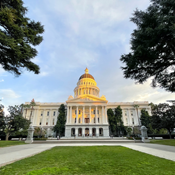
District Taxes and Sales Delivered in California (Publication 105)
Special Situations
Registered sellers of vehicles, undocumented vessels, and aircraft
If you are a registered seller of vehicles, undocumented vessels, or aircraft, you must generally apply tax to your sale or lease at the tax rate in effect at the California location where your customer will register or license their purchase.
This is true regardless of where the item is sold or delivered. If a district tax is in effect at the registration or licensing location, the total tax rate for the district (statewide rate + district rate) will apply to your sale. For more information, please see publication 34, Motor Vehicle Dealers.
Delivery to a location inside a special tax district and "engaged in business"
The total tax rate in effect in a special tax district (statewide rate + district rate) generally applies to sales delivered or shipped into the district. However, if you are not engaged in business in the district, you are not required to collect the district use tax. Instead, you may calculate the tax due on your sale at the statewide rate of 7.25 percent (see "Courtesy collection of district use tax," below). You are considered to be engaged in business in a special tax district and must report and pay district use tax if any of the following apply:
- Maintain, occupy, or use, directly or indirectly, or through a subsidiary or agent, a permanent or temporary office, place of distribution, sales or sample room, warehouse or storage place, or other physical place of business in the district.
- Have a representative, agent, or independent contractor operating in the district on your behalf or under your authority, or under the authority of your subsidiary, for the purpose of making sales, taking orders, assembling or installing merchandise, training customers, making deliveries, or otherwise establishing or maintaining a market for your products.
- Receive rental payments from the leases of tangible personal property that is located in the district, such as leases of machinery, equipment, and furniture.
- Own or lease real property or tangible personal property in the district, such as machinery, equipment, furniture or a computer server.
- Sell or lease vehicles or undocumented vessels which will be registered in a district.
- Have total combined sales of tangible personal property in California or for delivery in California by you and all persons related to you exceeding $500,000 in the preceding or current calendar year (see "Additional district use tax collection requirement" section below).
As noted above, you may be engaged in business in a special tax district even if you do not have a permanent location there. For example, if the sales representative for your Calaveras County business travels to San Joaquin County to take an order, you are considered to be engaged in business in the San Joaquin Transportation Authority special tax district. Tax would apply to your sale at the full rate in effect for San Joaquin County. You would report the San Joaquin Transportation Authority district tax on Schedule A of your sales and use tax return.
Additional district use tax collection requirement
Beginning April 25, 2019, a retailer is engaged in business in a district if, during the preceding or current calendar year, the total combined sales of tangible personal property in California or for delivery in California by the retailer and all persons related to the retailer exceed $500,000. A person is related to a retailer if they have a relationship with the retailer described in Internal Revenue Code section 267(b) and the related regulations.
Accordingly, beginning April 25, 2019, any retailer required to be registered with the CDTFA, whether located inside or outside of California that meets the $500,000 threshold is engaged in business in every district in California whether or not they have a physical presence in those districts. As such, these retailers are required to collect the district use tax on taxable sales made for delivery in those districts that impose a district tax. Retailers that do not meet the $500,000 threshold are still engaged in business in any district(s) in which they have a physical presence. For more information, see publication 44, District Taxes (Sales and Use Taxes), and our online guide Use Tax Collection Requirements Based on Sales into California Due to the Wayfair Decision.
Delivery outside special tax districts
Some sales of merchandise and certain types of vehicles, aircraft, and undocumented vessels may qualify for an exemption from a district's sales or use tax. Please see publication 44, District Taxes, (Sales and Use Taxes) for more information.
Courtesy collection of district use tax
Generally, if you are not engaged in business in a special tax district and you ship by common carrier into the district, your customer is liable for the district use tax. As a courtesy to your customer, you may choose to collect the district use tax from them. If you do, it should be shown on the customer's invoice and you must report it on Schedule A of your return and pay it to us.
Sales to aircraft common carriers; fixed-price contracts
The information in this publication may not apply to your sales to aircraft common carriers or sales involving fixed-price contracts. For help, please visit the CDTFA's website at www.cdtfa.ca.gov or contact the Customer Service Center by calling 1‑800‑400‑7115 (TTY:711).
Revision September 2023
